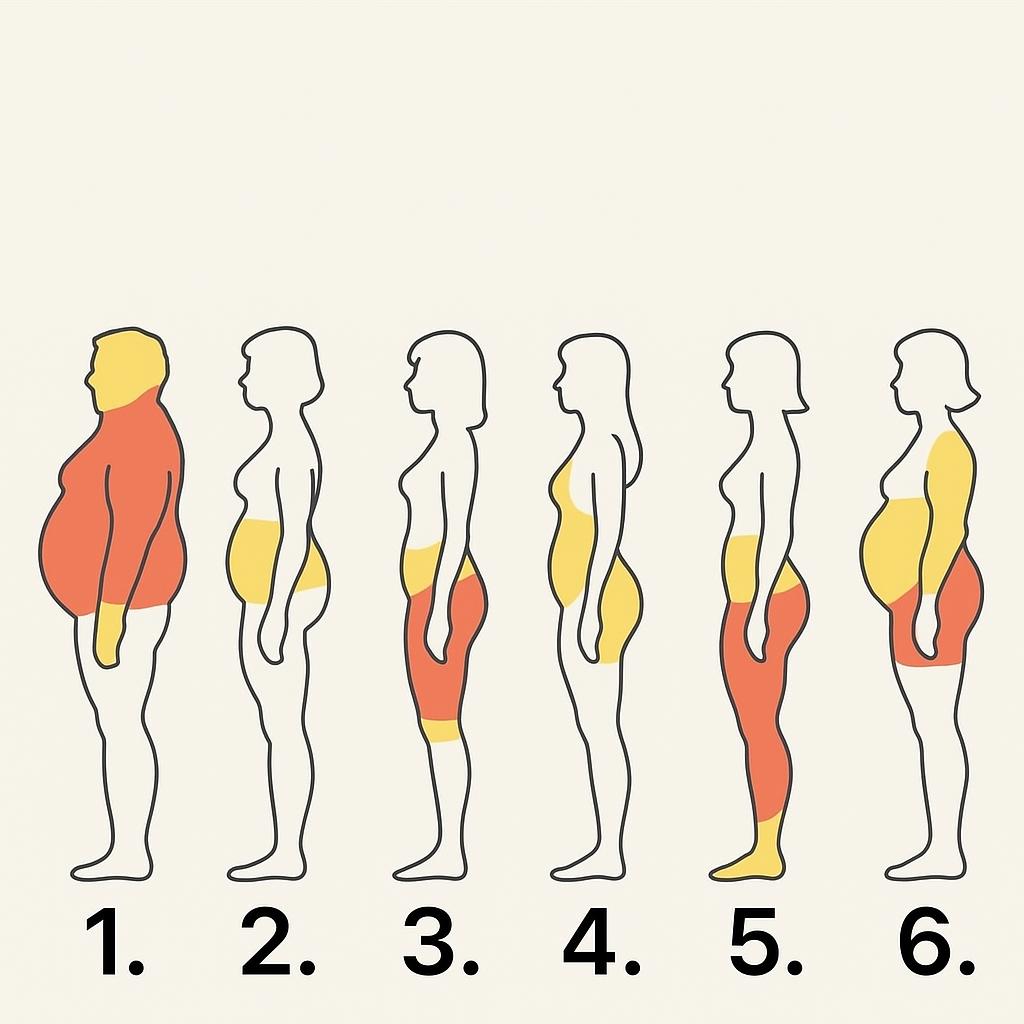Not all weight gain is created equal. The location where fat is stored on your body often reveals more about your lifestyle, hormones, and stress levels than you might think. The body types shown in the image represent six common fat distribution patterns. Each type has a unique cause — and a different solution. Let’s break it down.
Type 1: Upper Body Fat (Full Body Obesity)
This pattern is usually linked to overeating and a lack of physical activity. People with this type tend to gain fat in the arms, chest, and especially the upper belly. It’s often associated with a high intake of processed foods and sugary beverages.
What’s happening?
Consuming more calories than you burn causes the body to store excess energy as fat, especially in the upper body. It may also indicate insulin resistance.
Type 2: Belly-Centered Fat (Lower Abdomen)
If most of your fat accumulates around the belly while the rest of your body remains slim, chronic stress is likely the culprit. Cortisol — the stress hormone — triggers the body to store fat in the abdominal region.
What’s happening?
When cortisol is elevated for long periods, it increases appetite and fat storage, particularly visceral fat that wraps around the organs in your abdomen.
Type 3: Lower Body Fat (Hips and Thighs)
This is more common in women and is often related to hormonal imbalance, especially excess estrogen. It leads to pear-shaped fat accumulation on the hips, thighs, and sometimes the lower stomach.
What’s happening?
Estrogen dominance — where there’s too much estrogen relative to other hormones — promotes fat storage in the lower body. It can be influenced by diet, birth control, and environmental toxins.
Type 4: Bloated Belly with Upper Back Fat
This type can be caused by excessive alcohol consumption, food intolerances, or digestive issues such as bloating, constipation, or gut inflammation.
What’s happening?
The body struggles to digest food properly or eliminate waste efficiently. This can result in bloating and visible puffiness in the midsection and back.
Type 5: Lower Body Fat and Swollen Legs
This type of fat is common among pregnant women or individuals with poor circulation and fluid retention. It is characterized by fat and swelling in the lower body, particularly the legs and ankles.
What’s happening?
Lymphatic and circulatory issues prevent the body from draining fluids efficiently, leading to swollen limbs and heaviness in the lower body.
Type 6: Protruding Belly with Upper Body Fat
This is a result of both inactivity and high cortisol levels. It’s common in people who live high-stress lives and have irregular sleeping or eating schedules.
What’s happening?
When the body is under constant stress and you’re not moving enough, it stores fat around the organs (visceral fat) and around the back and chest.
How to Fix It – Solutions by Type
Type 1 (Full Body Fat):
•Follow a calorie-controlled, whole-food-based diet
•Incorporate 30–45 minutes of cardio five times a week
•Reduce sugary drinks and processed snacks
•Consider strength training to improve metabolism
Type 2 (Belly Fat – Stress Related):
•Practice stress-reducing activities: yoga, meditation, breathing exercises
•Get 7–8 hours of sleep daily
•Eat magnesium-rich foods (spinach, almonds) and avoid sugar binges
•Do light exercises like walking or swimming
Type 3 (Lower Body – Hormonal):
•Avoid processed soy and foods with artificial hormones
•Add cruciferous vegetables (broccoli, cauliflower) to your diet
•Engage in resistance training focused on the legs and glutes
•Consider checking hormone levels with a healthcare provider
Type 4 (Bloated Belly – Digestive):
•Eliminate foods that cause bloating (dairy, gluten, or soda for some)
•Increase fiber intake and drink more water
•Add probiotics or fermented foods to your diet
•Eat slowly and chew food thoroughly to support digestion
Type 5 (Lower Body & Leg Swelling):
•Reduce salt intake to avoid water retention
•Elevate your legs during rest
•Walk daily to support circulation
•Drink plenty of water to flush excess fluids
Type 6 (Stress + Sedentary Lifestyle):
•Prioritize daily movement — even a brisk walk helps
•Set consistent sleep and meal schedules
•Reduce screen time before bed
•Eat a clean diet focused on lean protein, vegetables, and healthy fats
Final Thoughts
Where you gain weight reveals more than just eating habits — it’s often tied to stress, hormones, or inactivity. The good news is: once you know the root cause, you can take targeted actions to reverse the pattern. Be patient, stay consistent, and listen to your body’s signals — your healthiest self is within reach.
